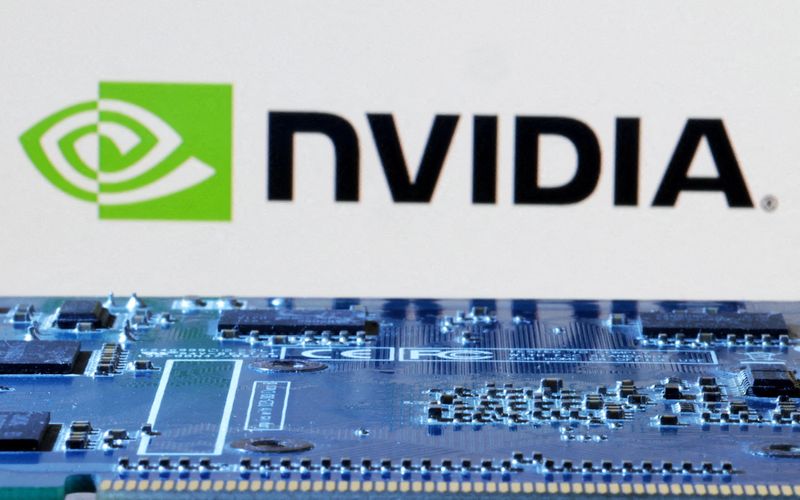
By Stephen Nellis and Aditya Soni
SAN FRANCISCO/BENGALURU (Reuters) – Nvidia’s revenue forecast on Wednesday disappointed Wall Street, raising questions over whether the artificial intelligence boom is waning. But the answer, according to Nvidia executives, analysts and investors, is a resounding no.
There is no shortage of companies eager to create new AI systems using Nvidia’s superior chips, and the world’s largest publicly listed company is selling them as fast as its chipmaking contractor Taiwan Semiconductor Manufacturing Co can make them.
Nvidia forecast its slowest revenue growth in seven quarters on Wednesday, pushing its stock down 2.5% after hours, and said supply chain constraints would lead to demand for its chips exceeding supply for several quarters in fiscal 2026.
Making these chips is hard, and a flaw that was found in one of its chips over the summer is not helping.
Nvidia’s new flagship chip, named Blackwell, is actually made up of multiple chips that have to be glued together in a complex process the chip industry calls advanced packaging. While TSMC is racing to expand capacity, packaging remains a bottleneck for Nvidia and other chip companies.
“Blackwell adds more advanced packaging from TSMC than prior chips, which adds a wrinkle,” said Ben Bajarin, CEO and principal analyst at research firm Creative Strategies. He expects Nvidia will have more demand than it can supply for all of 2025.
Missteps by Nvidia have exacerbated the issues.
The design flaw in Blackwell forced Nvidia to undertake what it calls a “mask change.” CEO Jensen Huang said the flaw, which has since been fixed, lowered Blackwell chip yields, which are the proportion of chips that come off the manufacturing line fully functional.
While Nvidia never elaborated on the flaw, complex chips like Blackwell can take months to produce because they require hundreds of manufacturing steps. Many of these steps involve shining ultraviolet light through a series of complex masks to project the image of a chip’s circuits on a disc of silicon – a process akin to printing the chip.
The mask change appears to have set back Nvidia’s production timelines and cost it money, analysts said.
“There’s the risk that the bottlenecks worsen rather than improve, and that could damage revenue projections,” said Michael Schulman, chief investment officer at Running Point Capital.
During a conference call with investors, Nvidia executives said the company has shipped about 13,000 samples of its new chip and expects to beat its initial estimates that it would sell several billion dollars’ worth this quarter.
“We’re at the beginning of our production ramp, which always comes with opportunities for yield improvement,” Huang told Reuters on Wednesday. “We are ramping Blackwell from zero to something extremely large. By definition, the laws of physics would say that there’s a limit to how fast you can ramp.”
In the short term, the production ramp-up is expected to pressure gross margins.
Nvidia executives warned investors the company’s margins would sink several percentage points to the low-70% range until production kinks are ironed out.
Hendi Susanto, a portfolio manager at Gabelli Funds, which holds Nvidia shares, said there was no doubt that demand for the company’s chips remained “absolutely and exceptionally strong” for the foreseeable future.
“The key focus is supply – how much supply Nvidia can produce,” he said.
(This story has been refiled to add Bengaluru to the dateline)
(Reporting by Stephen Nellis in San Francisco and Aditya Soni and Arsheeya Bajwa in Bengaluru; Editing by Sayantani Ghosh and Jamie Freed)
EMEA Tribune is not involved in this news article, it is taken from our partners and or from the News Agencies. Copyright and Credit go to the News Agencies, email news@emeatribune.com Follow our WhatsApp verified Channel




